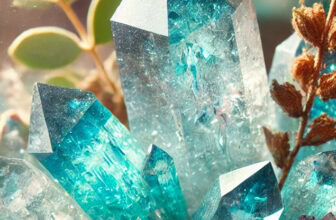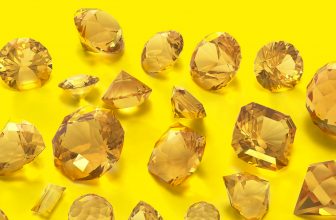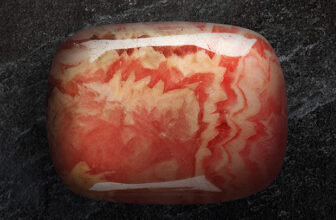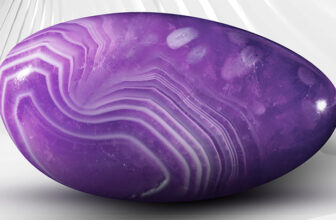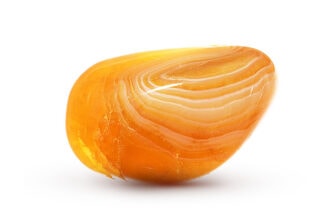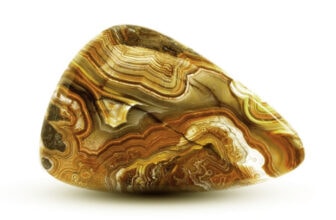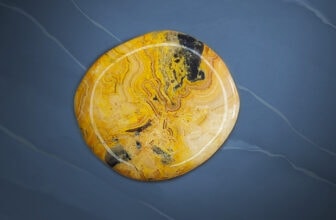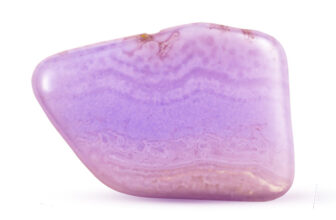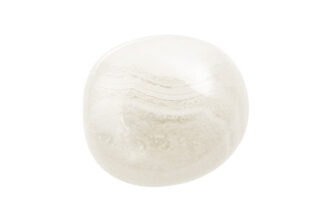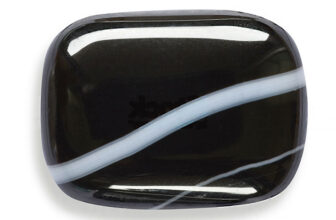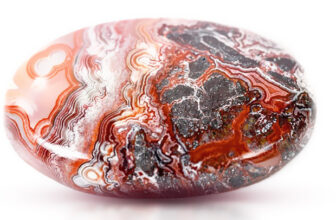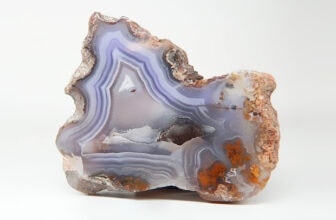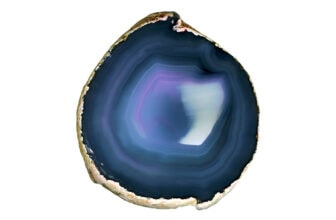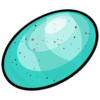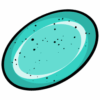The Soothing Power of Crystal Touchstones
 What if something as simple as holding a small, polished stone could quiet your racing thoughts? That’s the promise of a touchstone – a smooth, compact piece of gemstone designed not just to be admired, but to be felt.
What if something as simple as holding a small, polished stone could quiet your racing thoughts? That’s the promise of a touchstone – a smooth, compact piece of gemstone designed not just to be admired, but to be felt.
Touchstones, also known as worry stones, are nature’s pocket-sized companions for calm. Their surfaces are intentionally smooth, their shapes often flattened or oval, inviting your thumb to rest, rub, and release tension. Unlike faceted gems that dazzle the eyes, touchstones appeal to the senses through texture and temperature. Cool at first, then warm in your hand, they seem to respond to human touch – as if they remember every moment of stillness they’ve helped create.
Placed within the Crystals Shapes & Forms family, touchstones occupy a unique niche. They’re more personal than a palm stone, smaller and more discreet, designed for the hand rather than display. A cabochon might be destined for jewellery, but a touchstone? It’s made for life on the move – a stone to keep in your pocket, on your desk, or between your fingers during moments of stress.
Part of their enduring appeal lies in this duality. A touchstone is both a beautiful object and a functional tool – an elegant union of art and psychology, mineral and mindfulness.
Origins and Ancient Connections
Why have humans always reached for smooth stones in times of stress? The answer stretches back thousands of years.
In ancient Greece, people carried small pebbles from the sea – water-worn and comforting – and rubbed them for focus or to release worry. Across Tibet, similar stones were held during meditation, their surfaces acting as tactile anchors for presence. In Celtic and Native American traditions, smooth stones were seen as objects of grounding and connection – tools that bridged human energy with the earth’s quiet rhythm.
The term touchstone itself, however, originally referred to something quite different. In the world of metallurgy, a touchstone was a piece of dark stone used to test the purity of gold or silver. By rubbing metal against it, assayers could read the streak it left behind – a literal measure of value. Over time, the word evolved metaphorically. A “touchstone” became anything that tests quality, truth, or authenticity.
Why a Touchstone Can Change Your Day
Have you ever caught yourself fidgeting when nervous – tapping a pen, twisting a ring, scrolling endlessly? Those small, restless movements are your body’s way of saying, “I need grounding.” A touchstone offers a healthier, more mindful answer.
At its core, a touchstone is a portable sanctuary. Small enough to slip into your pocket, yet potent enough to shift your state of mind, it gives the hands something gentle to do when the thoughts grow loud. The simple motion of rubbing your thumb across its smooth surface can activate a calm cascade in the nervous system – a physical cue that whispers: you’re safe, stay present.
The Science of Soothing Touch
While crystal enthusiasts often speak of energy and vibration, there’s also real neuroscience behind this practice. The repetitive motion of rubbing a stone engages tactile sensory pathways, encouraging rhythmic, predictable feedback that the brain interprets as calming. The smooth surface provides consistent texture – neither sharp nor coarse – and that sensory predictability can help regulate anxious patterns in the brain.
It’s the same principle that makes fidget tools or stress balls effective, but with a far more natural, meaningful twist. Each touchstone carries the subtle variations of its mineral structure – the faint ridges of quartz, the silky sheen of obsidian, the soft warmth of rose quartz – offering a uniquely organic connection.
Emotional and Metaphysical Benefits
From a metaphysical viewpoint, touchstones act as anchors for intention. Many people use them during meditation, prayer, or deep breathing exercises. You might hold one to focus on calm, clarity, or courage. The stone becomes a tactile reminder of that state – a physical embodiment of something invisible but felt.
Some find that specific minerals resonate differently:
- Amethyst for serenity and clarity.
- Rose Quartz for emotional healing and gentle self-compassion.
- Obsidian or Hematite for grounding and protection.
- Tiger’s Eye for focus and resilience.
Subtlety and Portability
One of the touchstone’s great strengths is its discretion. You can hold it quietly in a meeting, during a stressful commute, or while lying awake at night. No one has to know it’s there. It doesn’t buzz or flash; it simply is. That subtlety makes it the perfect companion for people who want a moment of grounding without drawing attention.
Unlike palm stones, which are often larger and meant for use during intentional breaks, touchstones are pocket-sized and ready for real life – your on-the-go antidote to overwhelm.
A Bridge Between Worlds
In a way, every touchstone serves as a bridge – between thought and feeling, between mineral and human, between stillness and movement. It’s not a magic charm that removes anxiety, but a gentle tool that helps you meet anxiety differently. When life feels scattered, it gathers your senses into one place – your hand.
Forms That Fit the Hand
What makes a stone so irresistible to hold? Why do our fingers instinctively trace its edges, following every curve as though reading a language older than words? The answer lies not only in its energy but also in its design – the way a touchstone fits perfectly into the hand, like it was made just for you.
The Classic Form: A Smooth Invitation
Most touchstones are small, oval, and softly flattened. They fit comfortably between the thumb and forefinger, smooth on both sides, shaped to invite touch. The surface feels familiar even the first time you hold it – not slippery, not rough, but alive with quiet texture.
This form is no accident. Lapidaries (stone polishers) design touchstones with ergonomics and sensation in mind. A well-made piece will feel balanced in weight and thickness, with rounded edges that rest naturally against the contours of your hand. It’s a physical language of comfort – an unspoken agreement between hand and stone.
The Thumb Indentation: The “Worry Stone” Curve
A beloved variation of the touchstone is the thumb-indented design, often called a worry stone. This version includes a shallow groove where your thumb can settle, creating a small rhythmic motion as you rub. It’s a simple adaptation, yet it transforms the stone into a perfect meditative tool – the groove guiding your thumb like a heartbeat, steady and reassuring.
Over time, this rhythmic touch develops a subtle intimacy. Many people say their worry stones begin to feel “personalized,” as if the warmth of their hand has etched something invisible into the surface.
Natural and Free-Form Touchstones
Not all touchstones follow the classic oval. Some artisans prefer a free-form approach, allowing the natural shape of the rough stone to determine its final form. These pieces retain a whisper of the wild – organic edges, slight asymmetry, or gentle curves that follow the mineral’s natural grain.
A free-form touchstone feels more like holding a fragment of the earth itself – imperfect, unique, and full of personality. For many collectors, this irregularity enhances the emotional connection, offering a tactile reminder that calm doesn’t have to mean uniform.
Material Variations and Surface Finishes
Touchstones come in nearly every gemstone imaginable, from the soft glow of moonstone to the depth of black tourmaline. Each mineral type creates a different tactile and energetic experience:
- Obsidian is glassy and cool, grounding but sharp in focus.
- Rose Quartz is smooth, almost buttery, with a gentle, comforting warmth.
- Labradorite catches subtle flashes of blue and gold – grounding and mystical all at once.
- Jasper, agate, and tiger’s eye offer fine patterns that you can trace with your thumb like miniature landscapes.
Some touchstones are polished to a mirror gloss, reflecting light like water. Others are left slightly satin or matte, providing a more grounded, earthy feel. The finish changes the entire experience – glossy stones feel sleek and meditative, while matte stones offer quiet resistance, a reminder of natural texture.
Word-Engraved and Artistic Touchstones
Another creative variation features engraved words or symbols. A single word – peace, breathe, courage, love – transforms a simple stone into a personal talisman. The letters are often shallowly carved and highlighted with contrasting pigment or left subtle and natural.
These engraved touchstones work beautifully for intention-setting: you hold the stone and repeat its word silently, letting your thumb follow the carved letters like a small mantra. Artists sometimes go further, combining engraving with metal inlay, painting, or symbolic markings from spiritual traditions.
Between Palm Stones and Worry Stones
In terms of size, touchstones occupy a middle ground. Palm stones are larger and fill the whole hand – ideal for meditation sessions or energy work. Touchstones, by contrast, are smaller and thinner, designed for spontaneous, everyday use. They can slip into a pocket, rest on a desk, or travel with you unnoticed.
Some pieces blur the boundary – slightly larger “carry stones” that still fit the hand but offer more surface to hold. The beauty of this form is flexibility: whether perfectly polished or gently organic, each touchstone serves the same essential purpose – to meet your hand where it needs comfort most.
Shaping, Carving, and Polishing Your Stone
Have you ever wondered how a rough, unremarkable piece of rock becomes something so irresistibly smooth that your fingers can’t stop returning to it? The transformation of a touchstone is almost alchemical – part art, part precision, part quiet patience.
It all begins with selection.
Choosing the Right Stone
Not every stone is meant to become a touchstone. Lapidaries – the craftspeople who cut and polish gemstones – choose rough pieces that are not only beautiful but also durable enough to withstand constant handling. A stone that’s too soft will scratch easily; one that’s too brittle might chip or fracture.
Quartz varieties (like amethyst, rose quartz, and aventurine) are favorites because they polish beautifully and feel satisfyingly solid in the hand. Obsidian, jasper, and agate are equally popular for their density and fine textures. Occasionally, artisans choose softer stones like selenite or calcite for their gentle glow, but those require extra care and lighter polishing.
The first step is to trim the rough – sawing off uneven edges to create an approximate oval or flattened shape. At this stage, it still looks crude, more like a river pebble than a finished touchstone. But the intention is already there: to coax a shape that will feel natural in a human hand.
The Art of Shaping
Once trimmed, the stone is ground against coarse abrasives, shaping it into a smooth outline. The artisan pays attention not just to size, but to feel – testing it frequently between their fingers, sensing how the curves will eventually rest against a thumb or palm.
If the design calls for it, a shallow thumb indentation is carved on one side. This delicate step demands both accuracy and empathy; carve too deep, and it feels unnatural. Too shallow, and the curve fails to guide the thumb. The best worry stones have a dip that feels like a small echo of your fingerprint – intimate and familiar.
From Rough to Radiance
After shaping, the stone begins its slow metamorphosis through progressive sanding. Each stage uses finer grits, smoothing away the last marks of coarseness. What starts as dull and grainy gradually turns sleek, as though the stone is remembering its own inner light.
For some stones, especially quartz and agate, this process can involve tumbling – a gentle mechanical method that polishes many stones at once by letting them roll together in a drum filled with grit and water. But for high-quality or custom touchstones, artisans usually polish by hand or wheel, controlling every contour and sheen.
The final polishing stage is where the magic happens. Using fine powders like cerium oxide or tin oxide, the surface is buffed until it gleams – soft as silk, reflective as water. Under the light, it catches subtle glimmers, but its true beauty only appears when it meets the warmth of skin. That’s when it becomes a touchstone, not just a polished gem.
The Balance Between Beauty and Comfort
A true touchstone is made not just to be admired, but to be used. That means comfort outweighs perfection. A lapidary will often round edges a little more, test the thickness again, and adjust the surface until it feels “quiet” – no harsh angles, no sharp transitions, just a continuous flow of curve.
Even in modern workshops with advanced tools, this tactile testing remains essential. Machines can grind and polish, but only a human hand can tell when a stone feels “right.”
Finding the Right Stone for You
How do you know when you’ve found your stone – the one that seems to hum softly in your palm, as if it recognizes you? Choosing a touchstone isn’t a logical process; it’s an intuitive handshake between you and the mineral world. Still, a few grounded tips can help you make the right connection.
Choosing Your Touchstone
Start with the senses. When you pick up a stone, pay attention to how it feels – not just in temperature or texture, but in tone. Is it calming? Invigorating? Heavy, or gently buoyant? Your body often knows before your mind does.
A good touchstone should:
- Fit comfortably between your fingers or rest naturally in your palm. Too large, and it feels bulky; too small, and you’ll fumble it.
- Feel smooth but not slippery. You want a texture that invites gentle motion – a surface that gives you something to feel, not something to chase.
- Draw you in visually or emotionally. Maybe it’s a color that steadies you, or a pattern that looks like clouds, or a vibration that just feels “right.”
You can also choose based on intention or need: grounding, focus, self-love, courage. Even if you’re not deeply metaphysical, assigning purpose to a stone gives it meaning – and meaning gives it power.
Using Your Touchstone
There’s no strict ritual, no rulebook. The beauty of touchstones lies in their simplicity. But here are some ways to weave them into daily life:
- Carry it with you. Slip it into your pocket, purse, or desk drawer. When you feel anxious, reach for it – your thumb will find the surface instinctively.
- Use it as a mindfulness cue. Inhale as your thumb moves forward, exhale as it returns. Let each cycle pull you deeper into the present.
- Anchor intentions. Hold your stone each morning and set an inner phrase – peace, clarity, strength. Revisit it throughout the day.
- Meditation partner. During quiet practice, hold the stone lightly and focus on its weight, texture, and subtle warmth. Let it remind you that grounding is tangible.
- Nighttime ritual. Place it by your bed or under your pillow to encourage restful energy and continuity between waking and rest.
Special Stones and Their Stories
If touchstones are tools for presence, the gem type shapes their personality. Each mineral has its own texture, density, and symbolic resonance. Some feel cool and glassy, others velvety or warm. Choosing among them is like selecting a voice that speaks to your current state of mind.
Popular and Beloved Choices
- Amethyst – The classic stone of tranquility. Its soothing purple tones make it ideal for easing tension, calming the mind, and promoting spiritual clarity. Perfect for meditation or sleep.
- Rose Quartz – Soft pink and nurturing. It’s often chosen for emotional healing, compassion, and self-kindness. The warmth it carries feels almost like a heartbeat.
- Black Obsidian – A mirror of depth and protection. Sleek, glassy, and grounding, it helps absorb chaotic energy and reestablish inner stillness.
- Tiger’s Eye – Golden brown bands shimmer like sunlight through shadow. Known for confidence and focus, it’s a wonderful stone to carry during demanding workdays.
- Green Aventurine – Often called the “stone of opportunity,” it feels refreshing and optimistic. A lovely choice for renewal and steady emotional balance.
- Labradorite – Flashing with blue and gold, it’s a stone of intuition and magic. Perfect for dreamers, creatives, and those seeking inspiration.
- Hematite – Metallic gray with satisfying weight. The ultimate grounding touchstone – solid, steady, and quietly powerful.
Textural and Visual Delights
Some people choose touchstones based on pattern and texture alone. The soft lines of agate invite tracing; the swirling landscapes of jasper feel meditative in themselves. Leopard skin jasper, moss agate, and rhodochrosite create natural artworks within their surfaces – tiny worlds to get lost in while calming the mind.
Why They Work – and When They Might Not
Touchstones may be small, but they have a surprisingly big impact. Still, like any tool or form, they shine brightest in certain contexts – and less so in others.
The Benefits: Why Touchstones Work So Well
1. Portable Calm.
They slip effortlessly into your pocket or purse, ready whenever life gets overwhelming. Unlike larger stones, you don’t need a sacred space or special setup – you just need a moment.
2. Tactile Therapy.
Touch is one of the most direct ways to regulate emotion. The simple act of holding and rubbing a stone brings your awareness back to the body, grounding scattered thoughts.
3. Beauty with Purpose.
Each touchstone is both art and aid – visually appealing, yet made to be handled. They merge aesthetic appreciation with emotional function, bridging the physical and spiritual beautifully.
4. Affordable Connection.
Compared to faceted gemstones or large display pieces, touchstones are often budget-friendly. They offer a gateway into the world of crystals without requiring elaborate investment.
5. Universally Accessible.
You don’t need to be a crystal expert to benefit from one. The act of holding something smooth and steady is instinctual – anyone can experience its calming rhythm.
The Limitations: When a Touchstone Might Not Be Ideal
1. Not for Show.
If your goal is visual brilliance or ornamental display, a faceted gem or cluster might serve you better. Touchstones are understated – designed to be felt, not flaunted.
2. Surface Wear.
Frequent use can gradually dull the polish or scratch softer minerals. This isn’t necessarily bad – some people find the wear personal and meaningful – but it’s something to note.
3. Limited Versatility in Jewelry.
Their flattened, curved shape makes them perfect for carrying, but not ideal for setting in rings or necklaces (unless custom-mounted).
4. Subtle Energy Output.
If you’re seeking a strong visual or energetic statement – like a large geode’s radiance – touchstones are quieter. Their power is personal, not performative.

